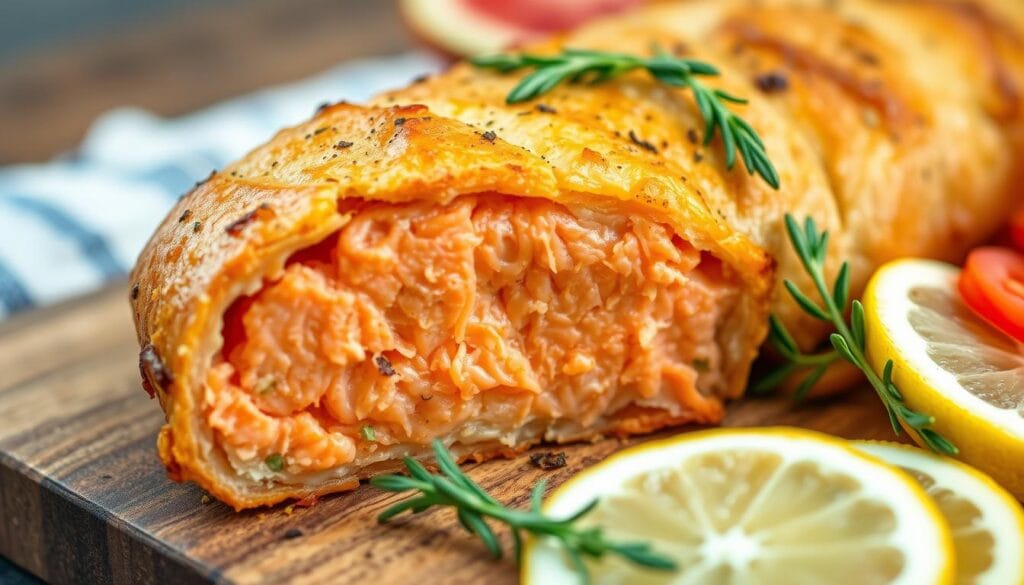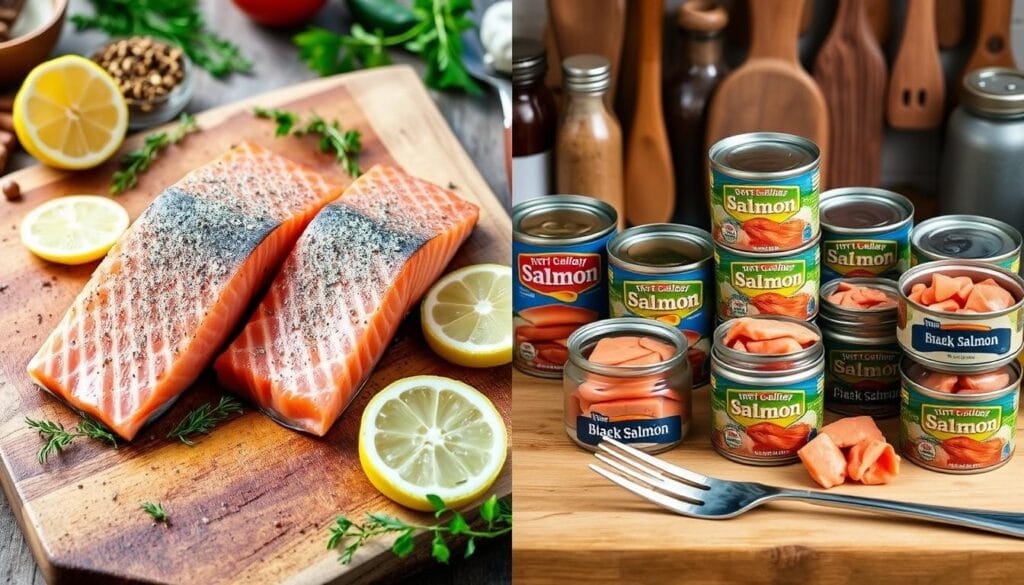Top Salmon Loaf Recipes for a Healthy and Tasty Meal
As the sun sets on a busy weeknight, a warm, comforting meal fills the air. This scent invites you to the dinner table. For many families, this smell is the irresistible aroma of homemade salmon loaf.
Salmon loaf is a dish that nourishes the body and soothes the soul. It combines the richness of succulent salmon with the perfect blend of seasonings and textures. This creates a satisfying and nutritious meal that pleases even the pickiest eaters.
Table of Contents
The Perfect Salmon Loaf Recipe for Beginners
Making a tasty and healthy salmon loaf is easy, even for beginners. This simple recipe is great for those new to cooking. With just a few ingredients and basic tools, you can make a delicious salmon loaf that will wow everyone.
Understanding Basic Ingredients
The main ingredients for a classic salmon loaf are:
- 1 can (15 ounces) of red salmon, with bones and skin removed
- 2 eggs
- 1/4 cup melted butter
- 1 1/2 cups milk
- 3 slices of soft bread, cubed
- Salt and pepper to taste
Essential Kitchen Tools
To make the perfect salmon loaf, you’ll need a few basic tools:
- Loaf pan
- Measuring spoons
- Stackable mixing bowls
- Cheese grater (for optional breadcrumb topping)
Time and Temperature Guidelines
Preparing this salmon loaf recipe is quick. It takes just 10 minutes to prep and 45-60 minutes to bake. Preheat your oven to 350°F (175°C). Bake until it’s golden and cooked through.
| Metric | Value |
|---|---|
| Prep Time | 10 minutes |
| Cook Time | 50 minutes |
| Total Time | 1 hour |
| Servings | 8 servings |
This salmon loaf recipe is a healthy and tasty option. It’s easy to make and perfect for beginners to try.
Benefits of Including Salmon Loaf in Your Diet
Salmon loaf is a nutritious and protein-rich meal that should be a regular part of your diet. It’s not only delicious but also packed with essential nutrients. These nutrients support your overall health and well-being.
One of the primary benefits of Salmon bake is its high protein content. A typical serving of this savory dish provides around 28-29g of protein. This makes it an excellent choice for maintaining muscle health and supporting an active lifestyle. Salmon is also a rich source of omega-3 fatty acids. These are known to promote heart health, reduce inflammation, and improve brain function.
Salmon loaf is also a good source of calcium, with approximately 250-278mg per serving. This contributes to the maintenance of strong bones and teeth. Furthermore, this dish is relatively low in carbohydrates, with only 8g per serving. This makes it suitable for various dietary needs, including low-carb or weight management plans.
Beyond the impressive nutritional profile, salmon loaf offers a convenient and versatile meal solution. The recipe can be customized with a variety of ingredients. This allows you to create a dish that caters to your taste preferences and dietary requirements. Whether you prefer a classic preparation or a gourmet variation, salmon loaf can be a delicious and nourishing addition to your weekly meal rotation.
“Salmon is an excellent source of protein, vitamins, and minerals, making it a nutritious and health-promoting ingredient in salmon loaf recipes.”
In conclusion, incorporating salmon loaf into your diet can provide a wealth of benefits. It supports muscle health and bone strength. It also promotes heart health and brain function. With its versatility and ease of preparation, salmon loaf is an ideal choice for busy individuals and families seeking a nutritious and satisfying meal option.
Classic Canned Salmon Loaf Recipe
Make your weeknights special with a tasty canned salmon loaf. It’s easy to make and packed with flavor. This dish is perfect for any home cook, whether you’re new to salmon or a seasoned pro.
Step-by-Step Mixing Instructions
- Preheat your oven to 350°F (175°C).
- In a large mixing bowl, combine one 14.75-ounce can of undrained canned salmon, 1 cup of crushed crackers (such as saltines or Ritz), 1/2 cup of milk, 1 beaten egg, 2 tablespoons of melted butter, 1 teaspoon of salt, and 1/4 teaspoon of black pepper.
- Mix all the ingredients together until well combined, ensuring the salmon is evenly distributed throughout the mixture.
- Grease a 9×5-inch loaf pan with non-stick cooking spray or butter.
- Transfer the salmon mixture to the prepared loaf pan, pressing it down firmly to create a compact and even surface.
Baking Tips and Techniques
Bake the canned salmon loaf in the preheated oven for 45-55 minutes. It’s done when the center is set and the top is golden. To cook evenly, rotate the pan halfway through. Let it cool for 10 minutes before slicing and serving.
Storage and Reheating Methods
Store leftovers in an airtight container in the fridge for 4-5 days. Reheat by pan-frying slices or baking the whole loaf at 350°F (175°C) for 10-15 minutes.
| Nutritional Information | Canned Salmon Loaf | Fresh Salmon Fillets |
|---|---|---|
| Calories | 195 kcal | 172 kcal |
| Protein | 16 g | 26 g |
| Fat | 14 g | 7 g |
| Carbohydrates | 1 g | 0 g |
| Sodium | 419 mg | 50 mg |
| Sugar | 0.3 g | 0 g |
Ingredient Substitutions and Variations
Want to try something new with your salmon loaf recipe? Here are some ingredient swaps and tweaks to make it your own. These tips are great for both beginners and seasoned cooks. They’ll help you tailor your salmon loaf to your liking.
Swap Out the Crumbs
Instead of saltine crackers, try using breadcrumbs or panko. Panko gives a crunchy outside, while breadcrumbs make it more traditional.
Citrusy Twist
For a zesty flavor, use lemon juice instead of rice vinegar. It adds a bright, citrusy taste that pairs well with salmon.
Cheesy Goodness
Add grated Parmesan cheese and chopped green onions for extra flavor. The cheese and onions enhance the salmon, making it rich and savory.
Fresh Salmon Variation
Use fresh salmon fillets instead of canned. Bake the salmon, then flake it into the mix. You’ll need about 1 1/2 cups of flaked salmon.
| Ingredient Substitutions | Variations |
|---|---|
|
|
These swaps and tweaks let you make a salmon loaf that’s truly yours. You can play with textures, flavors, and even the type of salmon. Get creative and enjoy your delicious homemade dish!
Gourmet Salmon Loaf with Parmesan and Herbs
Take your salmon loaf to the next level with a mix of Parmesan cheese and herbs. You can use fresh or dried herbs. This mix of flavors will make your dish stand out and impress everyone.
Fresh vs. Dried Herbs
You can choose between fresh or dried herbs for your dish. Fresh herbs add a bright flavor but need more prep work. For this recipe, use 1 tablespoon each of fresh dill and parsley.
If you prefer dried herbs, use 1 teaspoon each of dried dill and parsley. This makes things easier.
Cheese Selection Guide
The right cheese is key to a gourmet salmon casserole . Parmesan adds a sharp, salty taste that pairs well with salmon. Adding a bit of mild cheddar cheese balances the flavors.
This mix of cheeses and herbs makes your salmon loaf recipe even better. It’s perfect for a gourmet salmon dishes dinner party.
“The combination of Parmesan cheese and fresh herbs takes this salmon terrine to a whole new level of deliciousness.”
Tips for Achieving the Perfect Texture
Making the perfect Salmon casserole needs focus and the right techniques. Start by flaking the salmon with a fork until it’s finely crumbled. This ensures the salmon is evenly spread, blending flavors well and creating a great salmon loaf texture.
For a lighter, fluffier moist salmon loaf, whip egg whites to stiff peaks. Then, gently fold them into the salmon mixture. This adds air, making the loaf light and fluffy. Also, coat the salmon with milk or broth to keep it moist and hold the loaf together.
To get a flaky salmon dish, don’t overwork the mixture. Fold the ingredients together gently. This helps keep the loaf light and lets the salmon’s flavor stand out.

“The secret to a perfect Salmon bake lies in the details – from flaking the fish to folding in the whipped egg whites, every step matters in creating that mouthwatering texture.”
By following these tips, you can make a salmon loaf that’s moist, flaky, and cohesive. It will surely impress your taste buds. Bon appétit!
Serving Suggestions and Side Dishes
Serving salmon loaf can be fun and creative. It goes well with many sauces and side dishes. This makes for a balanced and tasty meal. Try classic tartar sauce or tangy salsa to boost the flavors.
Sauce Pairings
For a classic taste, use creamy tartar sauce or cool tzatziki. Zesty remoulade or lemon-dill sauce can add freshness. For something bold, try barbecue or chili-lime sauce.
Complementary Vegetables
- Steamed broccoli: A nutrient-dense side that complements the salmon loaf’s texture and flavor.
- Roasted asparagus: Tender and slightly charred asparagus spears make for a vibrant accompaniment.
- Mixed green salad: A simple salad with a light vinaigrette dressing can provide a refreshing contrast to the Salmon terrine.
For a heartier meal, pair Salmon casserole with roasted potatoes or a light rice pilaf. These sides balance the protein in the salmon, making dinner complete.
Remember, the secret to a great Salmon patty loaf dinner is to try new sauces, veggies, and sides. With a bit of creativity, you can turn this simple dish into a gourmet meal everyone will love.
Fresh vs Canned Salmon: Making the Right Choice
Choosing between fresh or canned salmon for your salmon loaf recipe is a big decision. Both have their own benefits, depending on what you like and what you’re making.
Canned salmon is a classic and easy pick for Salmon meatloaf It’s cheaper and lasts longer than fresh salmon. It also has soft bones and skin, which are packed with nutrients and mix well into the loaf.
Fresh salmon, on the other hand, can make your loaf taste better. You need to bake the fillet and then flake it with a fork. About 1 ½ cups of flaked cooked fresh salmon is needed to replace three cans in most recipes. Fresh salmon lets you pick the best fish for your taste and health needs.
| Feature | Canned Salmon | Fresh Salmon |
|---|---|---|
| Convenience | High | Low |
| Shelf Life | Long | Short |
| Nutrition | Includes bones and skin | Depends on preparation |
| Flavor | Traditional | Elevated |
| Cost | Lower | Higher |
So, whether to use fresh salmon or canned salmon for your salmon loaf depends on your taste, budget, and recipe. Both can make a tasty and healthy salmon loaf that you’ll love.

Common Mistakes to Avoid When Making Salmon Loaf
When making a salmon loaf, it’s key to avoid common mistakes. One big one is not flaking the salmon finely enough. This can make the loaf less cohesive and textured. To fix this, make sure to break down the salmon into small, uniform pieces before mixing it into the loaf.
Troubleshooting Guide
Another mistake is overmixing the ingredients. This can make the loaf dense and heavy. To get the right texture, mix the ingredients just until they’re combined. Also, make sure there’s enough liquid in the recipe to prevent a dry, crumbly loaf.
Expert Tips
If the edges of your Salmon bake brown too quickly, cover it with foil for the last 10 minutes. This helps the center cook evenly without the edges getting too dry. Lastly, let the loaf cool for about 10 minutes before slicing. This helps it set properly and prevents it from falling apart.







